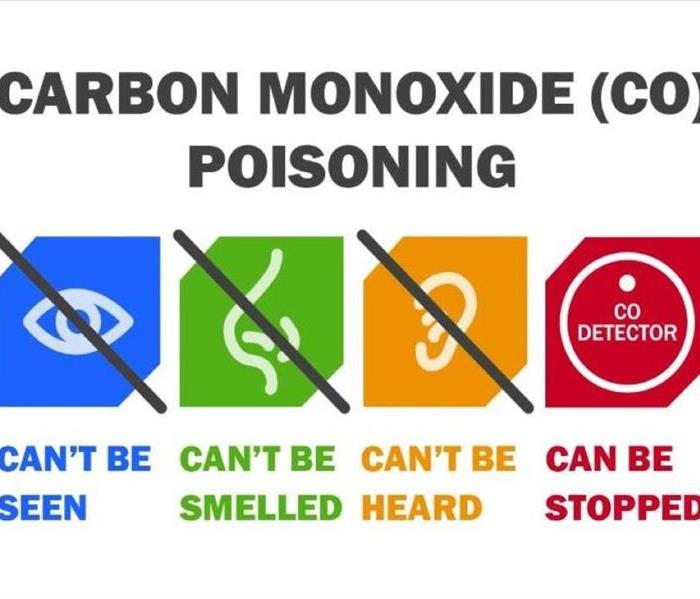Fire Prevention Week - Carbon Monoxide Safety
10/5/2021 (Permalink)
 Carbon monoxide - odorless, colorless, tasteless - can be detected and sickness can be prevented. Take the necessary steps to protect your family.
Carbon monoxide - odorless, colorless, tasteless - can be detected and sickness can be prevented. Take the necessary steps to protect your family.
October 3-9, 2021 is Fire Prevention Week
Carbon Monoxide - often called the 'silent killer' - is an invisible, odorless, colorless gas created when fuels (such as gasoline, wood, coal, natural gas, propane oil, or methane) burn incompletely. In the home, heating and cooking equipment that burn fuel can be sources of carbon monoxide.
The National Fire Protection Association (NFPA) shares this important information about carbon monoxide:
- Carbon monoxide (CO) alarms should be installed in a central location on every level of the home - for the best protection, interconnect CO alarms throughout the home so that one sounds, they all sound.
- Follow the manufacturer's recommendations for placement and mounting height.
- Choose a CO alarm that is listed by a qualified testing laboratory.
- Educate yourself on the number to call if the CO alarm sounds.
- Test CO alarms at least once a month and replace them according to the manufacturer's instructions.
- If the audible trouble signal sounds, check for low batteries. If the battery is low, replace. If the signal still sounds, call the fire department.
- If the CO alarm sounds, move to fresh air right away - outdoors if possible or near an open window or door. Call for help from a fresh air location and stay there until emergency personnel declare it is safe to reenter the home.
- If you need to warm up your vehicle, remove it from the garage. Make sure the exhaust pipe is not covered with snow.
- During and after a snowstorm, make sure vents for dryer, furnace, stove, and fireplace are clear of snow build up.
- If you use a generator be sure to place in a well-ventilated location outdoors away from windows, door, and vent openings.
- Gas or charcoal grills can produce CO and should only be used outdoors.
Home Heating Equipment
Never use an oven to heat your home. If you use a fireplace, ensure the flue is adequately vented. Fuel-burning heating equipment and chimneys should be inspected by a professional every year before the cold weather arrives.
Carbon Monoxide Facts
A person can be poisoned by a small amount of CO over an extended period of time or by a large amount in a short period of time.
In 2010, US fire departments responded to an estimated 80,000+ non-fire CO incidents in which carbon monoxide was found (an average of 9 calls per hour).
Remember, carbon monoxide is colorless, odorless, and tasteless, but very dangerous. Know the signs and symptoms of carbon monoxide poisoning and do your part to prevent it.






 24/7 Emergency Service
24/7 Emergency Service